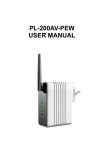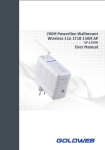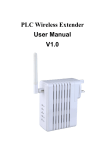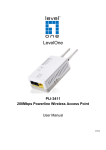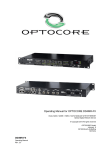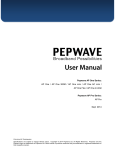Download 200Mbps Powerline PLV-200AV-PEWN User Manual
Transcript
200Mbps Powerline PLV-200AV-PEWN User Manual V1.0 PLV-200AV-PEWN_User Manual Contents 1 Overview ............................................................................................................ 1 2 Hardware Description......................................................................................... 3 2.1 LED Status and Button Description ....................................................... 3 2.2 Interface Description.............................................................................. 5 2.3 3 4 Hardware Installation............................................................................. 6 2.3.1 System Requirements ................................................................ 6 2.3.2 Before You Begin ........................................................................ 6 2.4 Operation Range ................................................................................... 6 2.5 How to Improve the Transmission Capacity .......................................... 6 Wireless Network Configuration......................................................................... 8 3.1 TCP/IP Settings ..................................................................................... 8 3.2 Log In to the Web Page....................................................................... 11 Web Configuration ........................................................................................... 12 4.1 4.2 Status................................................................................................... 12 4.1.1 Device Information.................................................................... 12 4.1.2 Network Information.................................................................. 12 4.1.3 User Information ....................................................................... 13 Network ............................................................................................... 15 4.2.1 Network Settings....................................................................... 15 4.2.2 LAN Settings............................................................................. 18 4.2.3 4.2.4 4.2.5 4.2.6 4.3 WLAN Settings ......................................................................... 20 4.2.3.1 Radio settings ............................................................... 22 4.2.3.2 Wireless Settings .......................................................... 23 4.2.3.3 Wireless Security Mode ................................................ 24 Time Management.................................................................... 29 Router Settings ......................................................................... 30 4.2.5.1 Dynamic Route ............................................................. 31 4.2.5.2 Static Route................................................................... 32 Powerline Settings .................................................................... 33 4.2.6.1 Local Device Configure................................................. 35 4.2.6.2 Remote Device Configure............................................. 35 4.2.6.3 Advance Configuration.................................................. 36 Security................................................................................................ 36 i PLV-200AV-PEWN_User Manual 4.4 4.5 5 6 4.3.1 WAN Access Configuration....................................................... 37 4.3.2 Firewall ..................................................................................... 38 4.3.3 MAC Filter................................................................................. 39 4.3.4 Port Filter .................................................................................. 39 Application ........................................................................................... 41 4.4.1 DDNS Configuration ................................................................. 41 4.4.2 Advanced NAT Configuration ................................................... 42 4.4.3 UPnP Configuration .................................................................. 46 4.4.4 IGMP Settings........................................................................... 46 4.4.5 Microsoft LLTD Settings............................................................ 47 Management........................................................................................ 47 4.5.1 Device Management................................................................. 47 4.5.2 User Management .................................................................... 48 4.5.3 Log File Management ............................................................... 49 How to Use the Security Pushbutton ............................................................... 50 5.1 Forming a HomePlug AV logical network ............................................ 51 5.2 Joining a Network ................................................................................ 51 5.3 Leaving a Network............................................................................... 52 Parameter and Specification ............................................................................ 54 ii PLV-200AV-PEWN_User Manual About User Manual This user manual mainly describes how to install and configure the PLV-200AV-PEWN wireless extender. Organization This user manual is organized as follows: Chapter Chapter 1 : Overview Description Provides a general overview of the PLV-200AV-PEWN wireless router, and the package list. Chapter 2 : Hardware Describes the front panel and the rear panel of Description the PLV-200AV-PEWN and the procedure for hardware installation. Chapter 3 :Wireless Describes how to configure network settings of Network Configuration your PC, and then connect to the PLV-200AV-PEWN. Chapter 4 : Web Describes how to navigate through the Web Configuration pages and how to configure the parameters. Chapter 5 : How to Use the Describes how to use the Security Pushbutton Security Pushbutton Chapter 6 : Parameter and Introduce the product system specification Specification Features PowerLine Feature Power supply range of 100 ~ 240VAC 50/60Hz Comply with HomePlug AV, and Co-existence with HomePlug 1.0 Nodes PowerLine PHY rate up to 200 Mbps iii PLV-200AV-PEWN_User Manual Support QAM 1024/256/64/16/8, QPSK, BPSK, and ROBO modulation schemes 128-bit AES Link Encryption with key management for secure power line communications Windowed OFDM with noise mitigation based on patented line synchronization techniques improves data integrity in noisy conditions Dynamic channel adaptation and channel estimation maximizes throughput in harsh channel conditions Priority-based CSMA/CA channel access schemes maximize efficiency and throughput Integrated Quality of Service (QoS) Enhancements: contention-free access, four-level priority based contention access, and multi segment bursting ToS and CoS Packet Classifiers Supports IGMP managed multicast sessions Wireless Feature Support IEEE802.11b, IEEE802.11g, IEEE802.11n, IEEE802.3, IEEE802.3u, IEEE802.11i, and IEEE802.11e Support 1T1R mode and transmission data rate is up to 150 Mbps Support WEP and WPA for data transmission security Support DHCP Server and Client Support firmware version upgrade via Web page Support restoring factory default settings Support wireless security authentication modes, including OPEN, WEP, WPA-PSK, WPA2-PSK, WPA/WPA2-PSK, 802.1X, WPA/WPA2-Enterprise. Support system status display Support system log iv PLV-200AV-PEWN_User Manual 1 Overview Thank you for choosing PLV-200AV-PEWN. PLV-200AV-PEWN (also called PLC Wireless Extender) is compatible with HomePlugAV, HomePlug 1.0, and 802.11b/g/n standards. PLV-200AV-PEWN supports CCK and OFDM. Its PowerLine PHY rate is up to 200 Mbps and wireless PHY rate up to 150 Mbps under the 11n mode. PLV-200AV-PEWN supports 128-bit AES encryption in PowerLine communication, and WEP, WPA, and IEEE 802.1X authentication in wireless communication, to ensure wireless communication security. Package list Please check whether your package list includes the following items: PLV-200AV-PEWN x 1 CD-ROM x 1 RJ45 x 1 Security Notes PLV-200AV-PEWN is intended for connection to the AC power line. For installation instructions, please refer to the installation section of this user manual. Before operating PLV-200AV-PEWN, read the following precaution information carefully: Follow all warnings and instructions marked on the product. Unplug the device from the wall outlet before cleaning. Use a damp cloth to clean the device. Do not use liquid cleaners or aerosol cleaners. Keep the device away from water. Keep the device away from radiators or heat registers. Do not use an extension cord to connect the device and the AC power source. Do not open the device to perform maintenance on your own. Otherwise, you may get an electric shock. Ask professional technicians to maintain the device. Unplug the device from the wall outlet and contact professional service personnel for help if you encounter the following situations: – Liquid is spilled into the device. – The device is exposed to rain or water. 1 PLV-200AV-PEWN_User Manual – The device fails to operate normally when you follow the operation – The performance of the device changes obviously. instructions to operate it. 2 PLV-200AV-PEWN_User Manual 2 Hardware Description 2.1 LED Status and Button Description There are 4 LED indicators on the front panel of PLV-200AV-PEWN. By observing their status, you can judge whether the device runs normally. The following table describes the LED status on the front panel. LED Indicator Power Ethernet Data Color Status Description Green On Green Blink - Off The device is powered on. System enters the power save mode. System is resetting. System is in the process of security setup. The device is powered off or it is down. Green On LAN connection succeeds. Green Blink Data is being transmitted in the LAN. Red On WAN connection succeeds. Red Blink Data is being transmitted in the WAN. - Off No LAN or WAN connection Green On/Blink PLC rate > 40 Mbps 3 PLV-200AV-PEWN_User Manual LED Indicator WLAN/WPS Color Status Orange On/Blink 20 Mbps < PLC rate < 40 Mbps Description Red On/Blink PLC rate < 20 Mbps Green On The WLAN connection has been activated. Green Blink Data is being transmitted in the WLAN. - Off The WLAN connection is not activated. Red On Connection succeeds under Wi-Fi Protected Setup. Red Blink - Off Negotiation is in progress under Wi-Fi Protected Setup. Wi-Fi Protected Setup is disabled. The following table describes the buttons on the front panel. Button Security Description The Security button is used to set the membership status. Pressing and holding the Security button for more than 10 seconds randomizes the NMK value. Pressing and holding the Security button for 0.5 to 3 seconds makes the adapter a member of the existing AVLN. Reset Use a fine needle to press Reset gently for 4 seconds and then release the button. The system reboots and restores to the factory defaults. WPS This button is used for enabling WPS PBC mode. If WPS is enabled, press this button, and then the extender starts to accept the negotiation of PBC mode. Note: Do not press the Reset button unless you want to clear the current settings. The Reset button is in a small circular hole on the rear panel. If you want to restore the default settings, please press the Reset button gently for 4 seconds with a fine needle inserted into the hole and then release the button. The system reboots and returns to the factory defaults. 4 PLV-200AV-PEWN_User Manual 2.2 Interface Description The following table describes interfaces and buttons on the rear panel. Interface/Button WAN LAN Description RJ45 WAN interface, for connecting WAN or the uplink network devices. RJ45 LAN interfaces, for connecting hub, switch, or computer in an LAN. 5 PLV-200AV-PEWN_User Manual 2.3 Hardware Installation 2.3.1 System Requirements Before installing PLV-200AV-PEWN, please make sure that the following items are available. At least one Ethernet RJ45 cable (10Base-T/100Base-T) One PLV-200AV-PEWN One PLC device for PowerLine communication A PC is already installed with the TCP/IP protocol and it can access the Internet. 2.3.2 Before You Begin Before you install PLV-200AV-PEWN, please pay attention to the following items: The Ethernet cables that are used to connect to a computer, hub, router or switch should be less than 100 meters. Do not place this device on an uneven or unstable surface or support. Do not put this device on the ground. Keep the device clean. Prevent the device from direct sunlight. Avoid any metal in the device. Place the device in the center of the area, and try to optimize the wireless coverage. 2.4 Operation Range The operation range of PLV-200AV-PEWN depends on the actual environment. The path and effect of signal transmission vary with the deployment in a house or an office. For PLC networks, the typical coverage is up to 5000 square feet, but the actual coverage varies with the power grid and the number of connected PLC terminal devices. For wireless transmission, the outdoor straight transmission distance for some devices can reach up to 300 meters, and the indoor straight transmission distance can reach up to 100 meters. 2.5 How to Improve the Transmission Capacity 6 PLV-200AV-PEWN_User Manual It is recommended to plug PLV-200AV-PEWN directly into a wall socket, not to a power strip. In this way, network transmission capacity can be optimized. 7 PLV-200AV-PEWN_User Manual 3 Wireless Network Configuration The Web management tool allows you to configure wireless function of PLV-200AV-PEWN and PLC function, the recommended browser is IE 5.0 or above. The following sections describe how to set the Internet connection, local Ethernet connection, and wireless connection, and how to access the Web page of PLV-200AV-PEWN. 3.1 TCP/IP Settings By default, the LAN IP address of PLV-200AV-PEWN is 192.168.0.1, the subnet mask is 255.255.255.0, and the DHCP server is enabled. It is recommended you set the network adapter to be Obtain an IP address automatically. Your PC acquires IP address, subnet mask, gateway, and DNS address automatically via the extender. If you know the setting of the current LAN interface, you can manually set the TCP/IP properties of the network adapter, so that your PC can communicate with the extender. You may manually set the network adapter by following the steps below: Step 1 Right click the icon of My Network Places (e.g., Windows XP) and select Properties in the menu. The Network Connections page appears. Step 2 Right click the network adapter icon and select Properties in the menu. The Local Area Connections Properties appears. (Note: If there are 8 PLV-200AV-PEWN_User Manual several network cards on your PC, it may not display the Local Area Connections Properties page. It may display other dialog boxes.) Step 3 Double click the Internet Protocol (TCP/IP) to display the Internet Protocol (TCP/IP) Properties page. 9 PLV-200AV-PEWN_User Manual Step 4 Select Use the following IP address and enter the IP address of the network adapter. The IP address should belong to the IP network segment 192.168. 0.X (X is a number between 2 and 254). Step 5 Set the subnet mask and then click the OK button to finish manual Step 6 After finishing setting, you may ping the default IP address of the setting. extender, to check whether the current connection between PC and the extender is normal. Click RUN… in the lower left corner on the desktop, and then enter ping 192.168.0.1 in the dialog box. See the following figure: Note: 10 PLV-200AV-PEWN_User Manual 192.168.0.1 is the default IP address of the LAN interface. If this IP address is changed and you need to ping the IP address of the extender, you should enter the current IP address in the dialog box above. Step 7 If PC can ping through the default IP address of the extender and the following page appears, it indicates that the connection between PC and AP is normal. 3.2 Log In to the Web Page Run the Internet Explorer (IE), enter http://192.168.0.1/ (the default IP address of PLV-200AV-PEWN) in the address bar, and press Enter. Enter the user name (admin, by default) and the password (Password, by default) on the login page. After clicking the Login button on the login page, you can log in to the Web page of the PLV-200AV-PEWN. 11 PLV-200AV-PEWN_User Manual 4 Web Configuration 4.1 Status After logging in to the Web page, system automatically displays the STATUS page. The submenu of STATUS contains DEVICE INFORMATION, NETWORK INFORMATION, and USER INFORMATION. 4.1.1 Device Information Choose STATUS > DEVICE INFORMATION to display the BASIC INFORMATION OF DEVICE page. In this page, you can view the device model, the ID, the hardware version, and the software version. 4.1.2 Network Information Choose STATUS > NETWORK INFORMATION to display the NETWORK INFORMATION page. 12 PLV-200AV-PEWN_User Manual In this page, you can view WAN and uplink information of the device. 4.1.3 User Information Choose STATUS > USER INFORMATION to display the USER INFORMATION page. 13 PLV-200AV-PEWN_User Manual This page shows you the device WLAN interface information, Ethernet information, and PLC device information. 14 PLV-200AV-PEWN_User Manual 4.2 Network The submenu of NETWORK contains NETWORK SETTINGS, LAN SETTINGS, WLAN SETTINGS, TIME MANAGEMENT, ROUTER SETTINGS, and POWERLINE SETTINGS. 4.2.1 Network Settings Choose NETWORK > NETWORK SETTINGS to display the NETWORK CONNECTION SETTINGS page. Access point mode Do as follows to configure the AP mode: (1) Select Enable Access Point Mode. (2) Click OK in the window displayed. 15 PLV-200AV-PEWN_User Manual The device now works in the AP mode. Router mode Unselect Enable Access Point Mode and the device works in the router mode. Setting DHCP connection (1) Select the connect type of DHCP. (2) Click the Save button to save the setting. The device will automatically get an IP address from DHCP server. Setting static connection (1) Select the connect type of Static. 16 PLV-200AV-PEWN_User Manual (2) Enter the following parameters – IP address – Subnet mask code – Default Gateway – Preferred DNS – Alternative DNS (3) Click the Save button to save the setting. Setting PPPOE connection (1) Select the connect type of PPPOE. 17 PLV-200AV-PEWN_User Manual (2) Enter the user name and password provided by the ISP. If you are not sure of the service name, you can leave it blank. (3) Select the preferred dial-up mode from the drop-down list. The default dialup mode is automatic connection. (4) Click the Save button to save the setting. Deleting an internet connection Click Delete Connection to delete an internet connection. 4.2.2 LAN Settings Choose NETWORK > LAN SETTINGS to display the LAN SETTINGS page. 18 PLV-200AV-PEWN_User Manual In this page, you can configure the parameters of the LAN port and DHCP server parameters. You can modify the IP address of the LAN port according to the actual network environment. The following table describes parameters and buttons in this page: Field Router IP Address Description The IP address of the LAN interface. The default IP address is 192.168.0.1. Router Subnet The subnet mask of the IP address of the LAN interface. Mask The default subnet mask is 255.255.255.0. 19 PLV-200AV-PEWN_User Manual Field Enable DHCP Description Enable or disable DHCP service. Server Starting IP address The first address in a consecutive IP address pool. Ending IP address The last address in a consecutive IP address pool. Subnet Mask The subnet mask that the DHCP server assigns. Leased Time After the DHCP lease time elapsed, the router automatically assigns new IP addresses for all connected computers. New Reserved IP Add a map relationship between the reserved IP address and MAC address. To reserve an IP address: z Under Reserved IP address List, click New Reserved IP Delete Reserved IP z Enter the MAC address and IP address z Click the Save button to save the settings. Select an entry of a reserved address and click the button to delete it. 4.2.3 WLAN Settings Choose NETWORK > WLAN SETTINGS to display the WIRELESS SETTINGS page. 20 PLV-200AV-PEWN_User Manual 21 PLV-200AV-PEWN_User Manual 4.2.3.1 Radio settings In this page, you may set parameters of the wireless mode, channel, and transmission power. The following table describes parameters in this page: Field Description Enable Radio Enable or disable the wireless LAN interface. Mode Select the appropriate wireless mode. Channel Select the working channel of the wireless network. The default channel is channel 6. Transmission Power Set transmit power. The default is 1, that is, the Channel Expansion Select a channel mode from the drop-down list. greatest transmit power. Mode Dynamic (default) Static 22 PLV-200AV-PEWN_User Manual Field Aggregation Description Enable or disable A-MSDU. MSDU is the aggregation of multiple MSDUs by using certain method and the multiple MSDUs forms a greater load. Tx Chainmask The stream number mask of wireless antenna Rx Chainmask The stream number mask of wireless antenna transmits. receivers. 4.2.3.2 Wireless Settings In this page, you may set the parameters of SSID, Short GI, RTS/CTS and so on. The following table describes parameters in this page: Field Description Select SSID Select an SSID from the drop-down list. Enable Wireless Enable or disable the wireless function for the selected SSID. Cancel Broadcast Enable or disable SSID broadcast. If it is enabled, the device broadcasts its SSID in the wireless network. Wireless clients can scan the SSID and access the corresponding wireless network. SSID Network name. The SSID can contain up to 32 23 PLV-200AV-PEWN_User Manual Field Description characters and can be letters, numerals, underlines, and any combinations of them. The SSID is case-sensitive. BSSID The MAC address of the wireless interface. Short GI Set the short guard interval. You may select Yes or No. The default guard interval is set to Yes. Yes: guard interval 400us No: guard interval 800us WMM Enable or disable WMM. After WMM is enabled, AP can process different types of wireless data by their priority levels. HT40 coexist RTS/CTS You may select Yes or No. The default coexist is No. Set the CTS/RTS threshold. The default RTS threshold is off. The value ranges from 256 to 2346. Fragmentation The default fragment threshold is off. The value ranges from 1 to 2347. 4.2.3.3 Wireless Security Mode In this page, you can set parameters of wireless security. In order to protect your privacy, you can configure wireless security, including WEP, WPA-PSK, WPA2-PSK, and 802.1X. (1) WEP 24 PLV-200AV-PEWN_User Manual The following table describes parameters in this page: Field Basic Authentication Mode Key length Description You can select Open, Share, and Both. Select the length of a key. You can select 64-bit,128-bit and 152-bit The Index of Current Network Select an index as the WEP key. Key Network Key (1/2/3/4) 64-bit : 10 Hex or 5 ASCII characters. 128-bit: 26 Hex or 13 ASCII characters. 152-bit: 32 Hex or 16 ASCII characters. (2) WPA-PSK 25 PLV-200AV-PEWN_User Manual The following table describes parameters in this page: Field WPA Passphrase Key Description Enter 8 to 63 ASCII characters or no more than 64 hexadecimal numbers WPA Encryption (3) Select TKIP , AES or TKIP AES. WPA2-PSK The following table describes parameters in this page: Field WPA Passphrase Key Description Enter 8 to 63 ASCII characters or no more than 64 hexadecimal numbers WPA Encryption (4) Select TKIP , AES or TKIP AES. WPA/WPA2-PSK 26 PLV-200AV-PEWN_User Manual For parameter descriptions, refer to WPA-PSK. (5) 802.1X The following table describes parameters in this page: Field Rekey Period Auth Server Address Auth Server Port Auth Server Secret Description Defines the period after which new keys will be issued to prospective originators. The IP address of the RADIUS server. The default port number is 1812. You may change it according to the server setting. The key that the RADIUS server needs for authentication. (6) WPA-Enterprise, WPA2-Enterprise, or WPA/WPA2-Enterprise 27 PLV-200AV-PEWN_User Manual The following table describes parameters in this page: Field WPA Encryption Description Select TKIP, AES, or TKIP AES. Robust Security Network (RSN), define the key RSN Preauth generation and distribution. This function is disabled by default. Reauth Period Defines the period for Reauth. Auth Server Address The IP address of the RADIUS server. Auth Server Port Auth Server Secret The default port number is 1812. You may change it according to the server setting. The key that the RADIUS server needs for authentication. WPS Progress WPS modes include PIN and PBC modes. WPS supports two operation modes, including the Enrollee and PBC mode. The Enrollee mode needs to apply PIN code negotiation. Enrollee Mode Step 1 Select Enrollee mode on the wireless client and the software of wireless client will generate a random PIN code, for example, 12345670. 28 PLV-200AV-PEWN_User Manual Step 2 Enter the PIN code of the wireless client (for example, 12345670) in the WIRELESS SETTINGS page. Step 3 Click the Save button on the WIRELESS SETTINGS page to save settings. PBC Mode Step 1 Press the WPS button on the device’s panel. Step 2 Enable the PBC function on the wireless client. In that case, PLV-200AV-PEWN and the wireless client will automatically establish connection. 4.2.4 Time Management Choose NETWORK > TIME MANAGEMENT to display the TIME MANAGEMENT page. The following table describes parameters in this page: Field Description 29 PLV-200AV-PEWN_User Manual Field Description Select an NTP first time server from the drop-down list. NTP first time server Or select other and enter the URL address of the time server manually. NTP second server Time Zone time Select an NTP second time server from the drop-down list. Or select other and enter the URL address of the time server manually. Select the time zone from the drop-down list. 4.2.5 Router Settings Choose NETWORK > ROUTER SETTINGS to display the ROUTER SETTINGS page. 30 PLV-200AV-PEWN_User Manual In this page, you can configure the dynamic router and static router. 4.2.5.1 Dynamic Route Click New Item to display the following page. 31 PLV-200AV-PEWN_User Manual The following table describes parameters in this page: Field RIP Mode Description Enable or Disable the RIP mode. RIP1 broadcasts a route to discover and maintain routing tables. RIP2 can be broadcast or multicast Version routing approach to discover and maintain routing tables. If the network approach to optimize the use of CIDR IP address allocation, it can only be used RIP2, RIP1 does not support CIDR Select Active or Passive. Active: Routers advertise their routes to other Operation routers. Passive: The passive router receives notice and updates its routing accordingly. 4.2.5.2 Static Route 32 PLV-200AV-PEWN_User Manual In this page, enter the destination IP address, subnet mask, and the gateway provided by you ISP. 4.2.6 Powerline Settings Choose NETWORK > POWERLINE SETTINGS to display the POWERLINE SETTINGS page. 33 PLV-200AV-PEWN_User Manual In this page, you can change powerline settings. 34 PLV-200AV-PEWN_User Manual 4.2.6.1 Local Device Configure You can configure a PLC device and the network password. 4.2.6.2 Remote Device Configure In this page, you can view the remote device list and set the remote device security. 35 PLV-200AV-PEWN_User Manual Set Security to Enable and you can set the password and MAC address for a remote device. Users can set up to eight devices at one time. 4.2.6.3 Advance Configuration The PLC QOS setting is only for traffic on the PLC, not for the whole router or AP’s QOS. It contains VLAN tags and TOS bits. Each VLAN tag or TOS bit has eight bits to identify the QOS settings, and four levels are available. By default the QOS setting is disabled: Under the priority mapping rules section, classify a special flow to a certain priority by clicking the New Rule button to generate a new configuration item to edit. Click the Save button to save the settings. 4.3 Security The submenu of SECURITY contains WAN ACCESSS CONFIGURATION, FIREWALL, MAC FILTER, and PORT FILTER. 36 PLV-200AV-PEWN_User Manual 4.3.1 WAN Access Configuration Choose SECURITY > WAN ACCESSS CONFIGURATION to display the URL FILTER page. Enable URL Filter and select Black list or White list. Click the Save button to save the settings. Black List: Indicates to prevent data that complies with the rule from passing through. White List: Indicates to allow data that complies with the rule to pass through only. Do as follows to add a URL filter rule: Step 1 Click New URL Filter to generate a URL rule. Step 2 Enter a URL in the URL Address field. Step 3 Click Save to save the settings. 37 PLV-200AV-PEWN_User Manual 4.3.2 Firewall Choose SECURITY > FIREWALL to display the FIREWALL AND RELEATED FUNCTIONS page. The following table describes parameters in this page: Field Description Low: You can use all service in the gateway from the WAN side. Middle: You cannot use TCP (1~1024 port) and UDP (1~66, 69~1024 port). Therefore, you cannot use the following frequently-used service: FTP Firewall Level (21), Telnet(23), Http(80), Rip(520) from the WAN side. High: You cannot use TCP (1~1024 port) and UDP (1~66, 69~1024 port). Therefore, you cannot use the following service: FTP (21), Telnet(23), Http(80), Rip(520), zebra(2601) from the WAN side. 38 PLV-200AV-PEWN_User Manual 4.3.3 MAC Filter Choose SECURITY > WAC FILTER to display the THE MAC ADDRESS FILTER RULES UNDER THE ROUTER MODE page. In this page, you can enable or disable the MAC filter. Enter MAC address in the text field and click Save to add the address to the MAC list. The format of MAC address is xx:xx:xx:xx:xx:xx (x is a hexadecimal value ranging from 0~9 or A~F). 4.3.4 Port Filter Choose SECURITY > PORT FILTER to display the ADD IP FILTER RULE page. 39 PLV-200AV-PEWN_User Manual In this page, you can enable or disable the IP filter. 40 PLV-200AV-PEWN_User Manual The following table describes parameters in this page: Field IP Address Filter Description Select Enable or Disable. Filter Mode Select Black List or White List. Protocol You can select TCP, UDP, or ICMP. Source IP Address Source Subnet Mask Enter the source IP Address range, for example 192.168.0.100~192.168.0.200. Enter the source subnet mask. Enter a port number or a port range to define the Source Port access to the Internet. If this parameter is left blank, all ports will be refused or allowed according to the filer rule. Destination IP Address Enter the destination IP address range. 4.4 Application The submenu of APPLICATION contains DDNS CONFIGURATION, ADVANCED NAT CONFIGURATION, UPNP CONFIGURATION, IGMP CONFIGURATION, and MICROSOFT LLTD SETTINGS. 4.4.1 DDNS Configuration Choose APPLICATION > DDNS CONFIGURATION to display the DDNS CONFIGURATION page. 41 PLV-200AV-PEWN_User Manual Dynamic DNS (DDNS) is mainly used to realize resolution between fixed domain names and dynamic IP addresses. For a user that uses a dynamic IP address, after the user obtains a new IP address when accessing to the Internet, the dynamic domain name software installed in the host sends the IP address to the dynamic domain name resolution server provided by the DDNS service provider and updates the domain name resolution database. When another user on the Internet tries accessing the domain name, the dynamic domain name resolution server returns the correct IP address. Do as follows to add a DDNS provider: Step 1 Select Enable Rules. Step 2 Select a DDNS provider. Step 3 Enter the Domain Name, user name, and password. Step 4 Click Save to save the settings. 4.4.2 Advanced NAT Configuration Choose APPLICATION > NAT CONFIGURATION to display the ADVANCED NAT CONFIGURATION page. 42 PLV-200AV-PEWN_User Manual ALG configuration ALG allows customized NAT traversal filters to plug into the gateway to support the address and port translation for application later control/data protocols, such as H.323, real-time streaming protocol (RTSP), layer 2 tunneling protocol (L2TP), IP security (IPSEC) and session initiation protocol (SIP). NAT-DMZ host DMZ (Demilitarized Zone) aims to solve the problem that external network can not access internal server behind firewall if you enable DMZ host. The router will forward the WAN IP packets to the DMZ host. But this also makes the computer face security risks, so this is the last resort. 43 PLV-200AV-PEWN_User Manual STUN setting The STUN protocol allows applications operating through a network address translator (NAT) to discover the presence of a network address translator and to obtain the mapped (public) IP address (NAT address) and port number that the NAT has allocated for the application User Datagram Protocol (UDP) connections to remote hosts. 44 PLV-200AV-PEWN_User Manual NAT-Virtual server Do as follows to add a virtual server: Step 1 Enter the server IP address. Step 2 Enter the internal server name Step 3 Specify the external port, protocol, internal port, and source IP. Step 4 Click Save to save the settings and the NAT-Virtual Server list will display the virtual server list 45 PLV-200AV-PEWN_User Manual 4.4.3 UPnP Configuration Choose APPLICATION > UPNP CONFIGURATION to display the UPNP CONFIGURATION page. You can enable or disable UPNP (Universal Plug and Play). 4.4.4 IGMP Settings Choose APPLICATION > IGMP SETTINGS to display the IGMP SETTINGS page. IGMP Snooping is used for multicast management and control. IGMP proxying enables a PC in the LAN to receive desired multicast traffic from the Internet. Disable IGMP proxying if you do not need this function. 46 PLV-200AV-PEWN_User Manual 4.4.5 Microsoft LLTD Settings Choose APPLICATION > MICROSOFT LLTD CONFIGURATION to display the LLTD CONFIGURATION page. LLTD (Link Layer Topology Discovery), Windows Vista automatically discovers other device’s link topology, and these devices are also compatible with LLTD. 4.5 Management The submenu of MANAGEMENT contains DEVICE MANAGEMNT, USER MANAGEENT, and LOG FILE MANAGEMENT. 4.5.1 Device Management Choose MANAGEMENT > DEVICE MANAGEMNT to display the DEVICE MANAGEMNT page. 47 PLV-200AV-PEWN_User Manual The following table describes parameters in this page: Field Restart Description Click the Restart button to restart the device. If you want to upload the firmware of the device, Update the firmware click Browse to choose the new firmware and then click Apply. The system begins to upgrade the firmware. Restore Defaults Click the Load Default button, the system returns to the factory default settings. 4.5.2 User Management Choose MANAGEMENT > USER MANAGEMNT to display the USER MANAGEMNT page. 48 PLV-200AV-PEWN_User Manual Set the user name and password in this page. Note: For security, it is strongly recommended to change the default user name and password. If you forget the password, you can press the Reset button to restore the device to the default settings. The default user name and password are admin and admin respectively. 4.5.3 Log File Management Choose MANAGEMENT > LOG FILE MANAGEMNT to display the LOG FILE MANAGEMNT page. 49 PLV-200AV-PEWN_User Manual If the record mode is enabled and a record level is selected, the events with the set level or higher are recorded. Click Access Records and the log information page is displayed. 5 How to Use the Security Pushbutton This chapter describes how to use the security pushbutton to add new devices to or remove devices from a HomePlug AV logical network (AVLN). 50 PLV-200AV-PEWN_User Manual You can monitor the operation progress and outcome by observing the Power LED status. 5.1 Forming a HomePlug AV logical network When two devices with different NMK values are connected to the same powerline, do as follows to form a logical network: Step 1 Press the Security button on the A or B for at least 10 seconds. The device will reset and restart with a random NMK. Step 2 Press the Security button on the first device A for less than 3 seconds. Step 3 Press the Security button on the second device B for less than 3 seconds. Press the button on B within 1 minute. Step 4 Wait for connection to complete. The Power LED on both devices will flash evenly at 1-second intervals until the operation succeeds or fails. It will illuminate steadily on successful completion. If an error occurs, the Power LED on the ‘adder’ will flash unevenly until the pushbutton on the ‘adder’ is pressed again or the ‘joiner’ is reset by holding the pushbuttons down for more than 10 seconds. 5.2 Joining a Network In a scenario where a new device (the joiner) attempts to join an existing network, any devices on the network can become the ‘adder’. Step 1 Press the Security button on the ‘joiner’ for at least 10 seconds. The device will reset and restart with a random NMK. Step 2 Press the Security button on the ‘joiner’ for at least 3 seconds. 51 PLV-200AV-PEWN_User Manual Step 3 Press the Security button on any network device for less than 3 seconds, making it the ‘adder’. Please press the Security button within 1 minute. Step 4 Wait for connection to complete. The Power LED on both devices will flash at 1-second intervals until the process succeeds or fails. It will illuminate steadily on success. If an error occurs, the Power LED on the ‘adder’ will flash unevenly until the Security button on the ‘adder’ is pressed again or the ‘joiner’ is reset by pressing the Security button for more than 10 seconds. 5.3 Leaving a Network A network exists. The user wants to remove one device, the ‘leaver’, from that network, for whatever reason. He may want to remove the device from service altogether or have it join another logical network. Step 1 Press the Security button on the ‘leaver’ for at least 10 seconds. The device will reset and restart with a random NMK. Step 2 Wait for reset to complete. The Power LED on the ‘leaver’ will momentarily extinguish during reset, flash during restart then illuminate steadily. No errors can occur. Once the process completes, the user may disconnect the device from the medium or join it to another logical network on the same medium. 52 PLV-200AV-PEWN_User Manual 53 PLV-200AV-PEWN_User Manual 6 Parameter and Specification PLC Module SPEC Chipset Intellon INT6400/INT1400 SDRAM: 64 Mbits Firmware Support North America/Europe/APAC/Japan Protocol HomePlug AV IEEE 802.3 10/100 Ethernet (100Mbps) IEEE 802.3u Fast Ethernet Co-exists with existing HomePlug 1.0 PLC Rate 200Mbit/s Data Rate - 65Mbps TCP, 90Mbps UDP TCP/UDP Modulation Band 2-30MHz Modulation Supports 1024/256/64/16/8-QAM, QPSK,BPSK and ROBO Schemes Encryption QoS 128-bit AES Support contention-free access, four-level priority based contention access, and multi segment bursting Support VLAN Priority Support ToS and CoS Packet Classifier Work Mode TDMA and priority based CSMA/CA Multicast Support Supports IGMP managed multicast sessions WiFi Module SPEC Chipset Atheros AR9331 Serial Flash 64 Mbits DDR SDRAM: 256 Mbits Protocol IEEE 802.11b/g/n IEEE 802.3/3x/3u Wireless 2.4GHz to 2.484GHz Frequency Range Channel 1~13 Wireless Signal 11b: 11/5.5/2/1 Mbps 54 PLV-200AV-PEWN_User Manual Rates With 11g: 54/48/36/24/18/12/9/6 Mbps Automatic 11n: 150Mbps in 40MHz mode 72Mbps in 20MHz mode Fallback Transmit Output 11n: 13-20dBm Power 11g: 14-21dBm 11b: 16-22dBm Receiver 11n: 150Mbps/-69dbM Sensitivity 11g: 54Mbps/-75dBm Work mode 1Tx/1Rx multi-BSSID Up to 8 BSSIDs Security WPA,WPA2,64/128/152-bit,WEP,802.1X,WPA/WPA2-Enter 11b: 11Mbps/-88dBM prise SSID hide, MAC Address Access Control List System SPEC System Support Windows 98SE, 2000, ME, XP 32/64 bit and Vista 32/64bit LED’s Power: Power on and off PLC: double color, indicator PLC Link and Activity WLAN: indicator Wireless Link and Activity WPS: indicator the status of WPS Authenticator. LAN: indicator the Ethernet Link and Activity Power Socket Support British, Euro, Japan, US and China power Ethernet Interface 2 x RJ45 for 10/100 Ethernet (Auto MDI/MDI-X) Antenna interface R/SMA x 1 Push Button Reset: reset system or restore default setup connector NMK: use to synchronized network password in PLC WPS: use to authenticated for wireless provide service Software update Support software update from WEB Consumption 6 W (Typed) Environment Requirement Operating 0 ºC to 40 ºC Temperature Storage -10 ºC to 70 ºC Temperature 55 PLV-200AV-PEWN_User Manual Operating 10% to 85% Non-condensing Humidity Storage Humidity 5% to 90% Non-Condensing Input Rating 100-240 VAC, 50/60Hz EMC and Safety Regulatory FCC Part 15 Class B, CE Compliance Safety UL Regulations Green Standard RoHS Physical Feature Physical L×W×H: 105mm×61mm×46mm Characteristics Weight 160g 56






























































